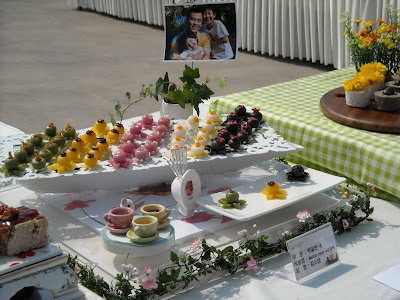
The weather has finally caught up with the season here, and the restaurants of Seoul have thrown open their doors. This is the time of year in Korea when my food obsession reaches a fever pitch--the exploding blossoms are gorgeous and the temperature's just right for hiking, but it's the scent of barbeque hanging in the air of every alleyway that really gets me excited.
Last night my co-workers took me to my favorite type of Korean eatery: small, quirky, and full of spicy grilled meat.

2.5 Dak Galbi lies in the shadows of Dongguk University and its six tables fill up quickly at meal times, but fortunately we arrived just as several groups of boisterous college students were clearing the place. We started off with the cold and refreshing soup that comes with each meal, which is a soft pink color due to the presence of red fermented cabbage.

For the main course, there were several varieties of dak galbi (the spicy chicken dish that you may recall I last ate out of a shovel) to choose from. We went for one that included sweet potato and duk (chewy rice cake) and skipped the options that featured cheese and baby octupi.
While we waited for the dak galbi, we enjoyed the hand-drawn pictures on the wall.

This hirsute chicken with Fabio pecs has just taken a little taste of himself and is declaring that he is amazed by and also trembling in fear of how delicious he is. It reminds me of one of my all-time favorite Korean signs, for a pigs' feet restaurant: a pig with a unicycle-like wheel in place of his chopped off feet, smiling and holding a plate brimming with pigs' feet.
The main course arrived in a decidedly plain vessel, but I quickly forgave the lack of inventiveness when I tasted how succulent the chicken was. It was lined with just enough fat to make it juicy and delicious, but not so much that I ended up with an uncomfortable mouthful of it. The sweet potatoes were cut into thin, tender slices, and I thought the sauce was perfectly balanced between sweet and spicy.

Two of my co-workers, both middle-aged Korean men, felt that it was too sweet, but these are guys who can't manage more than one bite of a standard western dessert because they have such a low tolerance. By my estimation it was slightly less sugary than bulgogi, but there was a nice kick to accompany it (although it wasn't nearly as spicy as some dak galbi I've had).
If only 2.5 Dak Galbi had a fun gimmick to recommend it in the same way that the shovel pub did. Wait a minute, is that duk in the shape of...? Oh, yes. Instead of the usual thick noodles, the 2.5 duk comes in the shape of hearts and stars.

I preferred it to regular duk, but I think that's just because the smaller pieces were more manageable than the typical large, chewy tubes. Evidently heart and star duk is a fad these days, and I'm crossing my fingers that we'll be seeing even wackier and more ingenious shapes in the future, perhaps in the form of dinosaurs or Yuna Kim.
After my co-workers and I were utterly stuffed with chicken, cabbage, sweet potatoes, and heart-shaped duk, the final course arrived. The blessing and curse of so many Korean meals is that just when you think you can't possibly eat anymore, the server turns the heat in the pan back up and the leftover sauce and bits on the bottom are fried with rice. Even though you're already moaning and sighing about how full you are, you somehow find a tiny bit of room for more because it's almost always the most delicious part of the meal. This was no exception.

If you're in the Dongguk area, 2.5 Dak Galbi is worth a visit for the friendly staff, the perfectly cooked dak kalbi, and the thoroughly amusing wall art. I'll definitely be back.
To get there, walk straight out of exit 2 at the Dongguk University stop. The sidewalk will become an alley; keep walking straight. When the alley diverges into two paths, take the one on the left (past the GS25). It's on the right a bit past Zen and before you reach Von's.
 I was raised on a steady supply of fresh-baked chocolate chip cookies, so tteok, the omnipresent Korean dessert made from glutinous rice flour, was a bland disappointment the first time I tried it. I thought that the subtlety might grow on me, but it hasn't. I used to wish there were some sort of element of interest to it until the time I was given pine needle flavored tteok by a co-worker, which made me much more appreciative of the basic, tasteless tteok.
I was raised on a steady supply of fresh-baked chocolate chip cookies, so tteok, the omnipresent Korean dessert made from glutinous rice flour, was a bland disappointment the first time I tried it. I thought that the subtlety might grow on me, but it hasn't. I used to wish there were some sort of element of interest to it until the time I was given pine needle flavored tteok by a co-worker, which made me much more appreciative of the basic, tasteless tteok.


















































